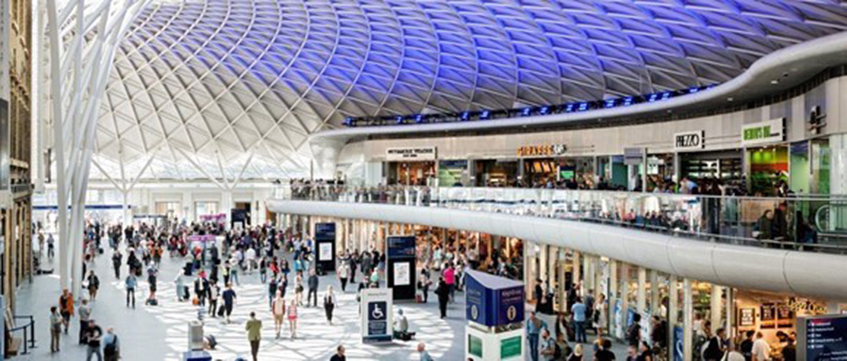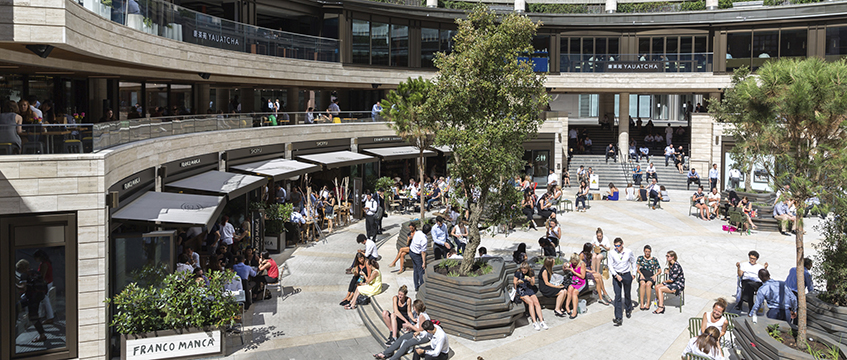The first trains on the Elizabeth Line are set to start rolling in autumn 2019 and while the Crossrail project may be running some £600m over budget, landlords with assets at or close to the new stations could be set to see the cash come rolling in.
Around 5.3m sq ft of residential, commercial and retail space will be delivered in and around the 10 new Elizabeth Line stations set to open in London. In a market that has so far this year had more than 15m sq ft of retail space made available through a spate of Company Voluntary Arrangements (CVAs) and administrations, that amount of extra space should be cause for concern.
And it would be, were it not alongside train stations. That’s because train stations are the holy grail of retail – it is almost impossible not to survive there.
Take WHSmith as an example. It has been voted the high street’s worst retailer for eight straight years by Which? thanks to its drab interiors (check out @whs_carpet on Twitter), poor customer service and confusing layouts.
It should have gone the same way as the dozen or so retailers that have called in administrators this year. But in its latest update to the market for the period from 1 March to 2 June, the retailer saw sales across its travel stores increase by 8%, compared with high street store sales, which were down 1%.
And it continues to expand, with plans to open between 15 and 20 stores in the UK by the end of its financial year.
Group chief executive Stephen Clarke says: “While there is some uncertainty in the broader economic environment, WHSmith serves millions of customers each week and continues to grow both internationally and in the UK.
“We continue to focus on profitably growth, cash generation and investing in the business to position us well for the future.”
Placemaking opportunities
It is these millions of customers – guaranteed customers – day in, day out, that makes retail in and around transport hubs so appealing to retailers and landlords alike.
British Land has more than £4bn of assets close to Crossrail stations in London – at Paddington Central, W2, Broadgate, EC2, Woolwich, SE18, and Ealing Broadway, W5 – which together will deliver more than 1m sq ft of retail and leisure space.

Claire Barber, head of central London retail and Meadowhall at BL, is excited about the opportunities that transport hubs are providing, not just for retail but also for placemaking.
She credits Argent’s redevelopment of King’s Cross in redefining the way occupiers (and shoppers) look at transport hubs.
King’s Cross Central has become a destination in its own right.
Last year it boasted a footfall of 10m, which it expects to double as the project continues to develop, and is home to retailers including Nike, Tom Dixon, Sweaty Betty, Space NK, Carhartt, Jigsaw and restaurants including Dishoom, Caravan and Leon.
Barber is hoping to deliver something similar at Broadgate, the 32-acre campus that sits alongside Liverpool Street station. Some 120m people already travel through Liverpool Street every year, and Crossrail will add a further 20m to that figure.
BL is developing 100 Liverpool Street at Broadgate, a 520,000 sq ft new office scheme that will provide 90,000 sq ft of retail across 26 units. By 2025, the amount of retail at the campus will have increased from 190,000 sq ft to 570,000 sq ft.
“The retail market is hard at the moment,” says Barber, “but not at Broadgate. And that is because of the volume of people that go through the transport hub.”

The evidence is clear in the deals recently agreed across the campus. Eataly, the Italian food hall concept, will open its first outlet in the UK at 135 Bishopsgate, taking 42,000 sq ft on the ground and first floors.
“Everyone expected Eataly, which had been looking at the UK for five years, to go to Covent Garden or the West End, but it chose us,” says Barber.
And so did Everyman Cinema and Inception Group’s Mrs Fogg’s.
She says it is transport hubs that are helping to make places like Broadgate so successful. “For retailers it of course about the quality of space, but it is also about the volume of people. At a station the element of risk is taken away. There is already an established footfall.”
New retail destinations
Could Crossrail be helping to create new prime retail spots across London, pulling tenants away from the prime central London patch? To the City, to Paddington (just three minutes from the West End once Crossrail is operational), even as far as Woolwich?
There is an argument that the eastern end of Oxford Street, traditionally seen as the shabby end, is already becoming a stronger retail pitch than the West End.
Derwent London is developing Soho Place, the 285,000 sq ft development above the newly rebuilt Tottenham Court Road station.
The scheme will include 36,000 sq ft of retail and is expected to see some 66m people travel through it a year in 2020, up from 40m people today.
The regeneration around the station has already seen big name retailers move to the “other end” of Oxford Street, including Primark, Zara and New Look. And there will be more.

Emily Prideaux, head of leasing at Derwent London, says: “Soho Place will be the new gateway to the eastern end of Oxford Street, fixing its position as central London’s most dynamic retail location.”
But it is convenience that will play the most important role in establishing whether the retail in and around stations really performs.
While the promise of tens of millions of people walking past your shop window is an attractive proposition for a retailer, operating in a transport hub is different to operating in a mall or on the high street. Your custom base may be captive and regular, but they are also often in a rush (or angry at delayed trains, so looking for a better customer experience in a store).
Barber says BL looks for operators that are able to handle volume and to be able to do it at speed. If they can’t serve at speed, they just won’t work, she says.
After all, the need to catch your train home will always beat buying whatever just caught your attention in the window display.
To send feedback, e-mail Samantha.McClary@egi.co.uk or tweet @Samanthamcclary or @estatesgazette











